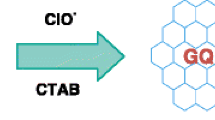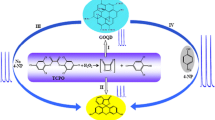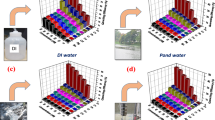Abstract
We report that the presence of graphene quantum dots (GQDs) causes an ~60-fold enhancement of the chemiluminescence (CL) caused by the reaction between rhodamine B (RhB) and Ce(IV) ion. A possible CL mechanism is established on the basis of fluorescence, CL and UV-vis spectra. It is suggested that the GQDs facilitate the oxidation of RhB and accelerate the generation of the CL emitting species, thus leading to stronger CL intensity. We further observed that 2,4-dichlorophenol at even trace levels exerts a diminishing effect on this CL system. This finding was exploited to design a CL method for determination of 2,4-dichlorophenol in the 0.1 to 5.0 μM concentration range, with a detection limit of 25 nM. The method was applied to the analysis of spiked real water and wastewater samples and gave satisfactory results.

Upon addition of GQDs, the CL from reaction between RhB and Ce(IV) is greatly enhanced. The addition of 2,4-dichlorophenol to this system decreases the CL intensity and this the basis of analytical method for determination of this compound.





Similar content being viewed by others
References
Zheng XT, Ananthanarayanan A, Luo KQ, Chen P (2015) Glowing graphene quantum dots and carbon dots: properties, syntheses, and biological applications. Small 11:1620–1636
Li L, Wu G, Yang G, Peng J, Zhao J, Zhu J-J (2013) Focusing on luminescent graphene quantum dots: current status and future perspectives. Nanoscale 5(3):4015–4039
Lin L, Rong M, Luo F, Chen D, Wang Y, Chen X (2014) Luminescent graphene quantum dots as new fluorescent materials for environmental and biological applications. TrAC Trends Anal Chem 54:83–102
Ocaña-González JA, Ramos-Payán M, Fernández-Torres R, Villar Navarro M, Bello-López MÁ (2014) Application of chemiluminescence in the analysis of wastewaters – a review. Talanta 122:214–222
Amjadi M, Manzoori JL, Hallaj T (2014) Chemiluminescence of graphene quantum dots and its application to the determination of uric acid. J Lumin 153:73–78
Hallaj T, Amjadi M, Manzoori JL, Shokri R (2015) Chemiluminescence reaction of glucose-derived graphene quantum dots with hypochlorite, and its application to the determination of free chlorine. Microchim Acta 182:789–796
Hao M, Liu N, Ma Z (2013) A new luminol chemiluminescence sensor for glucose based on pH-dependent graphene oxide. Analyst 138:4393–4397
Dong Y, Dai R, Dong T, Chi Yand Chen G (2014) Photoluminescence, chemiluminescence and anodic electrochemiluminescence of hydrazide-modified graphene quantum dots. Nanoscale 6:11240–11245
Xue W, Lin Z, Chen H, Lu C, Lin J-M (2011) Enhancement of ultraweak chemiluminescence from reaction of hydrogen peroxide and bisulfite by water-soluble carbon nanodots. J Phys Chem C 115:21707–21714
Lin Z, Xue W, Chen H, Lin J-M (2012) Peroxynitrous-acid-induced chemiluminescence of fluorescent carbon dots for nitrite sensing. Anal Chem 83:8245–8251
Lin Z, Xue W, Chen H, Lin J-M (2011) Classical oxidant induced chemiluminescence of fluorescent carbon dots. Chem Commun 48:1051–1053
Amjadi M, Manzoori JL, Hallaj T, Sorouraddin MH (2014) Direct chemiluminescence of carbon dots induced by potassium ferricyanide and its analytical application. Spectrochim Acta A 122:715–720
Teng P, Xie J, Long Y, Huang X, Zhu R, Wang X (2014) Chemiluminescence behavior of the carbon dots and the reduced state carbon dots. J Lumin 146:464–469
Amjadi M, Manzoori JL, Hallaj T, Sorouraddin MH (2014) Strong enhancement of the chemiluminescence of the cerium(IV)-thiosulfate reaction by carbon dots, and its application to the sensitive determination of dopamine. Microchim Acta 181:671–677
Jiang J, He Y, Li S, Cui H (2012) Amino acids as the source for producing carbon nanodots: microwave assisted one-step synthesis, intrinsic photoluminescence property and intense chemiluminescence enhancement. Chem Commun 48:9634–9636
Dou X, Lin Z, Chen H, Zheng Y, Lu C, Lin J-M (2013) Production of superoxide anion radicals as evidence for carbon nanodots acting as electron donors by the chemiluminescence method. Chem Commun 49(52):5871–5873
Shi J, Lu C, Yan D, Ma L (2013) High selectivity sensing of cobalt in HepG2 cells based on necklace model microenvironment-modulated carbon dot-improved chemiluminescence in Fenton-like system. Biosens Bioelectron 45:58–64
Zhou Y, Xing G, Chen H, Ogawa N, Lin J-M (2012) Carbon nanodots sensitized chemiluminescence on peroxomonosulfate–sulfite–hydrochloric acid system and its analytical applications. Talanta 99:471–477
Amjadi M, Manzoori JL, Hallaj T (2015) A novel chemiluminescence method for determination of bisphenol abased on the carbon dot-enhanced HCO− 3–H2O2 system. J Lumin 158:160–164
Wang DM, Gao MX, Gao PF, Yang H, Huang CZ (2013) Carbon nanodots-catalyzed chemiluminescence of luminol: a singlet oxygen-induced mechanism. J Phys Chem C 117:19219–19225
Lin Z, Dou X, Li H, Chen Q, Lin J-M (2014) Silicon-hybrid carbon dots strongly enhance the chemiluminescence of luminol. Microchim Acta 181:805–811
Olaniran AO, Igbinosa EO (2011) Chlorophenols and other related derivatives of environmental concern: properties, distribution and microbial degradation processes. Chemosphere 83:1297–1306
Feng Q, Li H, Zhang Z, Lin J-M (2011) Gold nanoparticles for enhanced chemiluminescence and determination of 2,4-dichlorophenol in environmental water samples. Analyst 136:2156–2160
Wu H, Ding Z, Peng M, Song Q (2012) Quantum dot induced phototransformation of 2,4-dichlorophenol, and its subsequent chemiluminescence reaction. Microchim Acta 178:203–210
Zhang J, Song Q, Hu X, Zhang E, Gao H (2008) Dye-sensitized phototransformation of chlorophenols and their subsequent chemiluminescence reactions. J Lumin 128:1880–1885
Feng Q-Z, Zhao L-X, Yan W, Ji F, Wei Y-L, Lin J-M (2008) Molecularly imprinted solid-phase extraction and flow-injection chemiluminescence for trace analysis of 2,4-dichlorophenol in water samples. Anal Bioanal Chem 391:1073–1079
Dong Y, Shao J, Chen C, Li H, Wang R, Chi Y (2012) Blue luminescent graphene quantum dots and graphene oxide prepared by tuning the carbonization degree of citric acid. Carbon 50:4738–4743
Dong Y, Li G, ZhouN WR, Chi Y, Chen G (2012) Graphene quantum dot as a green and facile sensor for free chlorine in drinking water. Anal Chem 84:8378–8382
He Y, Wang X, SunJ JS, Chen H, Gao F, Wang L (2014) Fluorescent blood glucose monitor by hemin-functionalized graphene quantum dots based sensing system. Anal Chim Acta 810:71–78
He Y, Sun J, Feng D, Chen H, Gao F, Wang L (2015) Graphene quantum dots: highly active bifunctional nanoprobes for nonenzymatic photoluminescence detection of hydroquinone. Biosens Bioelectron 74:418–422
Wu Z, Li W, Chen J, Yu C (2014) A graphene quantum dot-based method for the highly sensitive and selective fluorescence turn on detection of biothiols. Talanta 119:538–543
Ma Y, Jin X, Zhou M, Zhang Z, Teng X, Chen H (2003) Chemiluminescence behavior based on oxidation reaction of rhodamine B with cerium (IV) in sulfuric acid medium. Anal Chim Acta 489:173–181
Hasanin THA, Tsunemine Y, Tsukahara S, Okamoto Y, Fujiwara T (2011) Chemiluminescence from an oxidation reaction of rhodamine B with cerium (IV) in a reversed micellar medium of cetyltrimethylammonium chloride in 1-hexanol–cyclohexane/water. Anal Sci 27:297–304
Hassanzadeh J, Amjadi M, Manzoori JL, Sorouraddin MH (2013) Gold nanorods-enhanced rhodamine B-permanganate chemiluminescence and its analytical application. Spectrochim Acta A 107:296–302
Amjadi M, Hassanzadeh J, Manzoori JL (2014) Determination of cyanide using a chemiluminescence system composed of permanganate, rhodamine B, and gold nanoparticles. Microchim Acta 181:1851–1856
Acknowledgment
This work was supported by a grant from Iran National Science Foundation (INSF 93024484).
Author information
Authors and Affiliations
Corresponding author
Electronic supplementary material
ESM 1
(DOC 336 kb)
Rights and permissions
About this article
Cite this article
Hallaj, T., Amjadi, M. Determination of 2,4-dichlorophenol in water samples using a chemiluminescence system consisting of graphene quantum dots, rhodamine B and cerium(IV) ion. Microchim Acta 183, 1219–1225 (2016). https://doi.org/10.1007/s00604-016-1749-z
Received:
Accepted:
Published:
Issue Date:
DOI: https://doi.org/10.1007/s00604-016-1749-z




